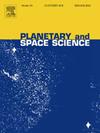JUICE任务上的MAJIS仪器模拟器:操作和科学案例的描述和应用
IF 1.7
4区 物理与天体物理
Q3 ASTRONOMY & ASTROPHYSICS
引用次数: 0
摘要
MAJIS(卫星和木星成像光谱仪)仪器是JUICE(木星冰卫星探测器)任务的一部分,是研究木星大气组成和动力学以及其冰卫星表面和外逸层的关键工具。为了优化观测计划和评估仪器性能,我们开发了一个辐射模拟器,可以准确地模拟来自木星系统各个目标的MAJIS预期信号。该模拟器综合了仪器参数、航天器轨迹、观测约束和木星的辐射环境。它提供必要的输出,包括信噪比(SNR)预测和针对不同观测情景的优化仪器设置。通过模拟辐射性能和消尖峰策略来减轻木星辐射带的影响,该工具有助于在整个MAJIS操作过程中改进观测策略。几个科学应用证明了模拟器的能力,从绘制木卫三和木卫二的表面到探测木星的外逸层排放和大气成分。在MAJIS探索木星系统期间,该模拟器是最大化MAJIS科学回报和确保最佳数据采集的关键资产。研究案例展示了模拟器模拟场景的能力,如Ganymede的高分辨率测绘、外逸层表征以及Io和木卫二上的热点探测。这些模拟证实了MAJIS在探测高信噪比的关键光谱特征方面的潜力,从而为木星系统的可居住性和成分多样性这一任务的主要目标做出重大贡献。本文章由计算机程序翻译,如有差异,请以英文原文为准。
A simulator of the MAJIS instrument onboard the JUICE mission: Description and application to operational and scientific cases
The MAJIS (Moons And Jupiter Imaging Spectrometer) instrument, part of the JUICE (JUpiter ICy moons Explorer) mission, is a crucial tool for investigating the composition and dynamics of Jupiter’s atmosphere, and the surfaces and exospheres of its icy moons. To optimize observational planning and assess instrument performance, we have developed a radiometric simulator that accurately models MAJIS expected signal from various Jovian system targets. This simulator incorporates instrumental parameters, the spacecraft trajectory, observational constraints, and Jupiter’s radiation environment. It provides essential outputs, including Signal-to-Noise Ratio (SNR) predictions and optimized instrument settings for different observational scenarios. By simulating both radiometric performance and de-spiking strategies to mitigate the impact of Jupiter radiation belt, the tool aids in refining observation strategies throughout the MAJIS operations. Several scientific applications demonstrate the simulator capabilities, from mapping the surfaces of Ganymede and Europa to detecting exospheric emissions and atmospheric composition on Jupiter. This simulator is a critical asset for maximizing MAJIS scientific return and ensuring optimal data acquisition during MAJIS exploration of the Jovian system. Study cases are presented for illustrating the capability of the simulator to model scenarios such as high-resolution mapping of Ganymede, exosphere characterization and hotspot detection on Io and Europa. These simulations confirm the potential of MAJIS for detecting key spectral features with high signal to noise ratio so as to provide major contributions to the main goals of the mission: habitability and compositional diversity in the Jovian system.
求助全文
通过发布文献求助,成功后即可免费获取论文全文。
去求助
来源期刊

Planetary and Space Science
地学天文-天文与天体物理
CiteScore
5.40
自引率
4.20%
发文量
126
审稿时长
15 weeks
期刊介绍:
Planetary and Space Science publishes original articles as well as short communications (letters). Ground-based and space-borne instrumentation and laboratory simulation of solar system processes are included. The following fields of planetary and solar system research are covered:
• Celestial mechanics, including dynamical evolution of the solar system, gravitational captures and resonances, relativistic effects, tracking and dynamics
• Cosmochemistry and origin, including all aspects of the formation and initial physical and chemical evolution of the solar system
• Terrestrial planets and satellites, including the physics of the interiors, geology and morphology of the surfaces, tectonics, mineralogy and dating
• Outer planets and satellites, including formation and evolution, remote sensing at all wavelengths and in situ measurements
• Planetary atmospheres, including formation and evolution, circulation and meteorology, boundary layers, remote sensing and laboratory simulation
• Planetary magnetospheres and ionospheres, including origin of magnetic fields, magnetospheric plasma and radiation belts, and their interaction with the sun, the solar wind and satellites
• Small bodies, dust and rings, including asteroids, comets and zodiacal light and their interaction with the solar radiation and the solar wind
• Exobiology, including origin of life, detection of planetary ecosystems and pre-biological phenomena in the solar system and laboratory simulations
• Extrasolar systems, including the detection and/or the detectability of exoplanets and planetary systems, their formation and evolution, the physical and chemical properties of the exoplanets
• History of planetary and space research
 求助内容:
求助内容: 应助结果提醒方式:
应助结果提醒方式:


